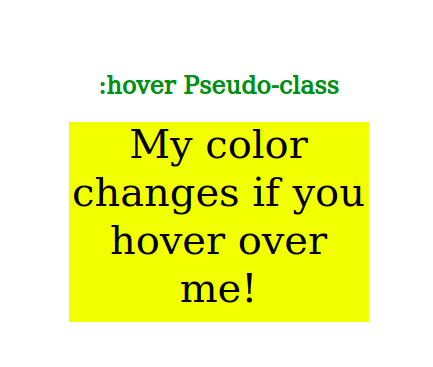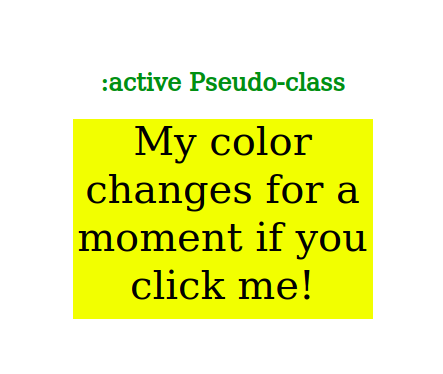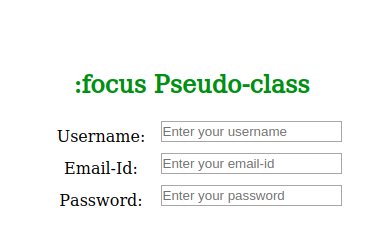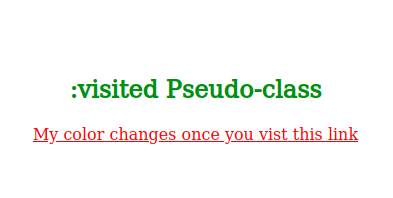CSS中的伪类用于定义元素的特殊状态。可以将其与CSS选择器结合使用, 以根据其状态为现有元素添加效果。例如, 当用户将鼠标悬停在元素上或访问链接时, 更改元素的样式。所有这些都可以使用CSS中的伪类来完成。
注意伪类名称不区分大小写。
语法如下:
selector: pseudo-class{
property: value;
}CSS中有很多Pseudo类, 但是最常用的类如下:
:hover伪类:
当我们的鼠标指针悬停在元素上时, 此伪类用于为元素添加特殊效果。下面的示例说明, 当鼠标进入框区域时, 其背景颜色从黄色变为橙色。
例子:
<!DOCTYPE html>
< html >
< head >
< title >CSS transition-property property</ title >
< style >
.box{
background-color: yellow;
width: 300px;
height: 200px;
margin: auto;
font-size: 40px;
text-align: center;
}
.box:hover{
background-color: orange;
}
h1, h2{
color: green;
text-align: center;
}
</ style >
</ head >
< body >
< h1 >Geeks For Geeks</ h1 >
< h2 >:hover Pseudo-class</ h2 >
< div class = "box" >
My color changes if you hover over me!
</ div >
</ body >
</ html >输出如下:

:active伪类:
该伪类用于选择一个元素, 该元素在用户单击时被激活。以下示例说明, 当你单击该框时, 其背景颜色会暂时改变。
例子:
<!DOCTYPE html>
< html >
< head >
< title >CSS transition-property property</ title >
< style >
.box{
background-color: yellow;
width: 300px;
height: 200px;
margin: auto;
font-size: 40px;
text-align: center;
}
.box:active{
background-color: orange;
}
h1, h2{
color: green;
text-align: center;
}
</ style >
</ head >
< body >
< h1 >Geeks For Geeks</ h1 >
< h2 >:active Pseudo-class</ h2 >
< div class = "box" >
My color changes for a moment if you click me!
</ div >
</ body >
</ html >输出如下:

:focus伪类:
该伪类用于选择用户当前关注的元素。它适用于表单中使用的用户输入元素, 并在用户单击它时立即触发。在下面的示例中, 当前聚焦的输入字段的背景颜色发生变化。
例子:
<!DOCTYPE html>
< html >
< head >
< title >CSS transition-property property</ title >
< style >
form{
width: 300px;
height: 200px;
margin: 0 auto;
text-align: center;
line-height: 2rem;
}
label{
width: 30%;
}
input{
background-color: default;
float: right;
}
input:focus{
background-color: grey;
}
h1, h2{
color: green;
text-align: center;
}
</ style >
</ head >
< body >
< h1 >Geeks For Geeks</ h1 >
< h2 >:focus Pseudo-class</ h2 >
< form >
< label for = "username" >Username:</ label >
< input type = "text" name = "username"
placeholder = "Enter your username" />
< label for = "emailid" >Email-Id:</ label >
< input type = "email" name = "emailid"
placeholder = "Enter your email-id" />
< label for = "Password" >Password:</ label >
< input type = "password" name = "Password"
placeholder = "Enter your password" />
</ form >
</ body >
</ html >输出如下:

:visited伪类:
该伪类用于选择用户已经访问过的链接。在以下示例中, 链接的颜色在被访问后即会更改。
例子:
<!DOCTYPE html>
< html >
< head >
< title >CSS transition-property property</ title >
< style >
body{
text-align: center;
}
h1, h2{
color: green;
}
a:visited{
color: red;
}
</ style >
</ head >
< body >
< h1 >Geeks For Geeks</ h1 >
< h2 >:visited Pseudo-class</ h2 >
< p >
< a href = "https://www.lsbin.org/" target = "_blank" >
My color changes once you vist this link
</ a >
</ p >
</ body >
</ html >输出如下:


